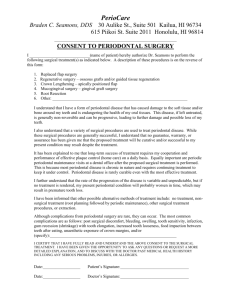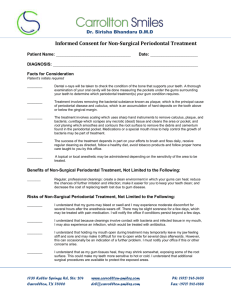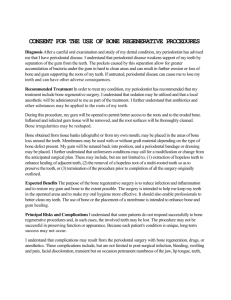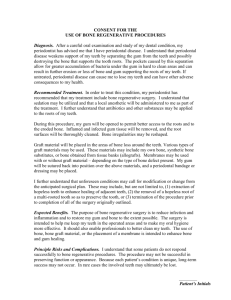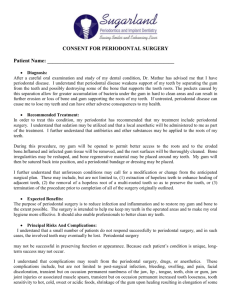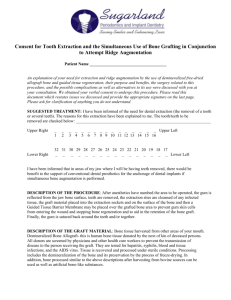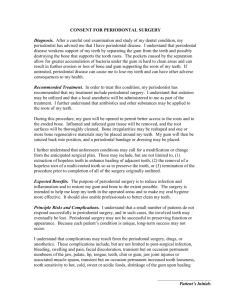CONSENT_PERIO_SURGERY_BONE_GRAFTING
advertisement
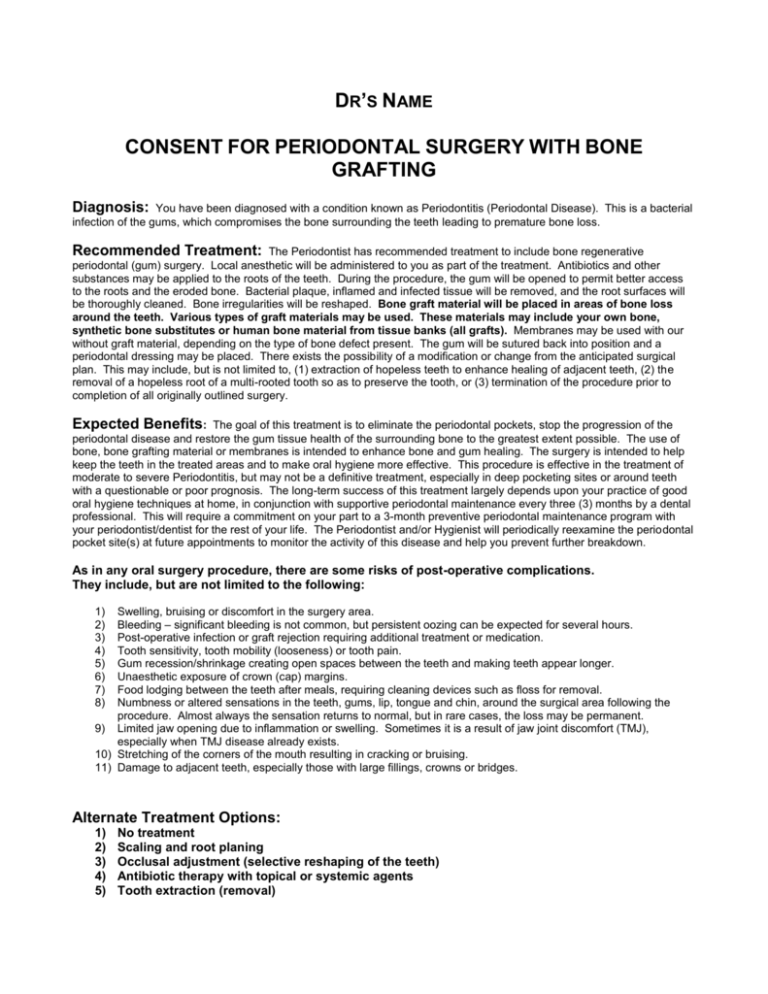
DR’S NAME CONSENT FOR PERIODONTAL SURGERY WITH BONE GRAFTING Diagnosis: You have been diagnosed with a condition known as Periodontitis (Periodontal Disease). This is a bacterial infection of the gums, which compromises the bone surrounding the teeth leading to premature bone loss. Recommended Treatment: The Periodontist has recommended treatment to include bone regenerative periodontal (gum) surgery. Local anesthetic will be administered to you as part of the treatment. Antibiotics and other substances may be applied to the roots of the teeth. During the procedure, the gum will be opened to permit better access to the roots and the eroded bone. Bacterial plaque, inflamed and infected tissue will be removed, and the root surfaces will be thoroughly cleaned. Bone irregularities will be reshaped. Bone graft material will be placed in areas of bone loss around the teeth. Various types of graft materials may be used. These materials may include your own bone, synthetic bone substitutes or human bone material from tissue banks (all grafts). Membranes may be used with our without graft material, depending on the type of bone defect present. The gum will be sutured back into position and a periodontal dressing may be placed. There exists the possibility of a modification or change from the anticipated surgical plan. This may include, but is not limited to, (1) extraction of hopeless teeth to enhance healing of adjacent teeth, (2) the removal of a hopeless root of a multi-rooted tooth so as to preserve the tooth, or (3) termination of the procedure prior to completion of all originally outlined surgery. Expected Benefits: The goal of this treatment is to eliminate the periodontal pockets, stop the progression of the periodontal disease and restore the gum tissue health of the surrounding bone to the greatest extent possible. The use of bone, bone grafting material or membranes is intended to enhance bone and gum healing. The surgery is intended to help keep the teeth in the treated areas and to make oral hygiene more effective. This procedure is effective in the treatment of moderate to severe Periodontitis, but may not be a definitive treatment, especially in deep pocketing sites or around teeth with a questionable or poor prognosis. The long-term success of this treatment largely depends upon your practice of good oral hygiene techniques at home, in conjunction with supportive periodontal maintenance every three (3) months by a dental professional. This will require a commitment on your part to a 3-month preventive periodontal maintenance program with your periodontist/dentist for the rest of your life. The Periodontist and/or Hygienist will periodically reexamine the periodontal pocket site(s) at future appointments to monitor the activity of this disease and help you prevent further breakdown. As in any oral surgery procedure, there are some risks of post-operative complications. They include, but are not limited to the following: 1) 2) 3) 4) 5) 6) 7) 8) Swelling, bruising or discomfort in the surgery area. Bleeding – significant bleeding is not common, but persistent oozing can be expected for several hours. Post-operative infection or graft rejection requiring additional treatment or medication. Tooth sensitivity, tooth mobility (looseness) or tooth pain. Gum recession/shrinkage creating open spaces between the teeth and making teeth appear longer. Unaesthetic exposure of crown (cap) margins. Food lodging between the teeth after meals, requiring cleaning devices such as floss for removal. Numbness or altered sensations in the teeth, gums, lip, tongue and chin, around the surgical area following the procedure. Almost always the sensation returns to normal, but in rare cases, the loss may be permanent. 9) Limited jaw opening due to inflammation or swelling. Sometimes it is a result of jaw joint discomfort (TMJ), especially when TMJ disease already exists. 10) Stretching of the corners of the mouth resulting in cracking or bruising. 11) Damage to adjacent teeth, especially those with large fillings, crowns or bridges. Alternate Treatment Options: 1) 2) 3) 4) 5) No treatment Scaling and root planing Occlusal adjustment (selective reshaping of the teeth) Antibiotic therapy with topical or systemic agents Tooth extraction (removal) ANESTHESIA 1. LOCAL ANESTHESIA: (Novocain, Lidocaine, etc) an injection used to block pain pathways in the surgical area. 2. LOCAL ANESTHESIA WITH NITROUS OXIDE: Nitrous Oxide (or laughing gas) helps to decrease uncomfortable sensations and offers some degree of relaxation. 3. LOCAL ANESTHESIA WITH ORAL SEDATION: a pill is taken for relaxation prior to giving local anesthesia. Whichever technique is used, the administration of any anesthesia medication involves certain risks. ANESTHESIA RISKS: Risks after the administration of a local anesthesia may include the following complications: Burning or pain on injection, edema (swelling), nerve paralysis (partial or permanent numbness), hematoma (bruising), infection, needle breakage, lip chewing, tissue sloughing or trismus (lock jaw). If a sedative is used: disorientation, confusion, nausea, vomiting or prolonged drowsiness may occur. Also, an allergic reaction, shock, seizure can occur possibly leading to more serious respiratory (lung) or cardiovascular (heart) problems which may require emergency care. Cardiovascular or respiratory emergencies can lead to hear attack, stroke, or even death. Fortunately, these complications and side effects are very rare. If you have any questions, PLEASE ASK. I have read and understand the above and give my consent for periodontal surgery. I understand that during the course of the procedure, unforeseen conditions may arise which necessitate procedure(s) that my Periodontist may consider necessary. I acknowledge that no guarantees or assurances have been made to me concerning the results intended from the procedure(s). I hereby certify that I clearly understand and comprehend the nature, purpose, benefits, risks and alternatives to (including no treatment), the proposed procedure(s). I have been given the opportunity to ask questions and they have been answered to my complete satisfaction. I further agree not to drive a car while under the influence of any sedative medication that the doctor has prescribed and to have a responsible adult accompany me until I am recovered from these medications. I have given a complete and truthful medical history, including all medications, drug use, pregnancy, or past adverse reactions. I confirm that I have read and understand the above consent form and that I speak, read and write English. ___________________________________________________________________________ Patient’s (or Legal Guardian’s) Signature Print Name Date ___________________________________________________________________________ Witness Signature Print Name Date

